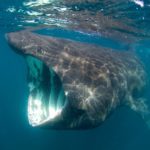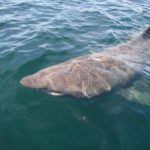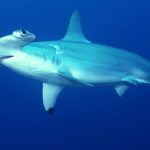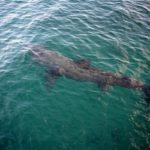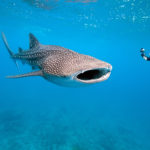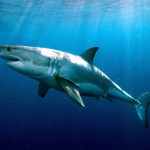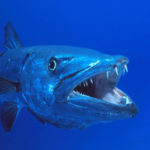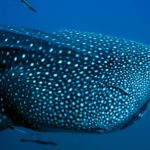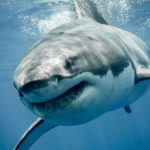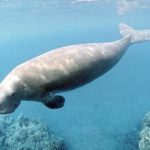Where do basking sharks live ?
 Basking sharks are found in the cool and warm temperate waters of all oceans. This coastal-pelagic species lives on the continental shelf at a depth of up to 910 m (according to other sources – up to 1264 m). The preferred temperature range is from 8 to 14.5 ° C, although sometimes basking sharks go into warmer waters. There is evidence that they cross the equator. They are often met at the shore or in narrow outlets from bays. They make seasonal migrations. The similarity of morphological characteristics of basking sharks inhabiting the Pacific and Atlantic Ocean, indicate that it is the same species. However, both populations are geographically isolated.
Basking sharks are found in the cool and warm temperate waters of all oceans. This coastal-pelagic species lives on the continental shelf at a depth of up to 910 m (according to other sources – up to 1264 m). The preferred temperature range is from 8 to 14.5 ° C, although sometimes basking sharks go into warmer waters. There is evidence that they cross the equator. They are often met at the shore or in narrow outlets from bays. They make seasonal migrations. The similarity of morphological characteristics of basking sharks inhabiting the Pacific and Atlantic Ocean, indicate that it is the same species. However, both populations are geographically isolated.
According to observations, which, as a rule, were made near the coast, their distribution is as follows:
Atlantic Ocean: from Newfoundland to Florida, southern Brazil and Argentina, South Africa, the Mediterranean and North Sea, off the coast of Norway and Iceland
Pacific Ocean: (Japan, Korea, China, the southern coast of Australia, New Zealand, Tasmania, Chile, Peru, Ecuador, Galapagos, and the entire coast from California to the Gulf of Alaska.
In high northern latitudes, including in the waters of Great Britain, basking sharks are most often found in surface waters from April to October. In winter, they can rarely be seen, as the copepods of Calanus, which they eat, usually concentrate on the surface in the summer months.
Migrations are associated with changes in temperature and the redistribution of plankton. The hypothesis is formally accepted, according to which in giant latitudes the basking sharks hibernate on deep water, and with the onset of heat migrate to the coastal shallow zone. High concentration of squalene in the fat of the liver in the spring and its successive replacement with vitamin A during the year at least partially confirms the presence of such migrations [18]. Some individuals appear in shallow water after the formation of the thermocline. The previously proposed hypothesis that the winter migration of basking sharks from coastal feeding areas to the northeast Atlantic is associated with hibernation at the bottom of the slope of the continental shelf in order to conserve energy reserves, has not been confirmed.
